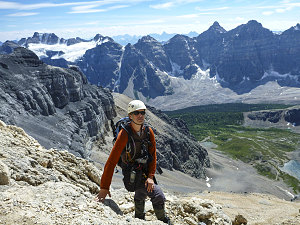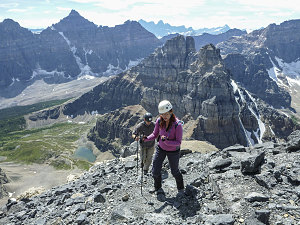The rock of the first cliff band was trivially easy to climb, and we were on top of it within a few minutes. Above the cliff band was a somewhat tricky slope of mixed gravel with small blocky outcroppings. We could see a bunch of other climbers above us at the base of the next cliff band, and we chose a zig-zaggy path up through this semi-loose blocky slope to them. In retrospect (and after closely looking at the official park scramble route guide), I think we should have turned more to the left, and angled up diagonally that way to the base of the second cliffs, then traversed back right horizontally to the second climbing section. As it was, our more direct but scrabbly ascent worked, but was perhaps not ideal.
The second cliff band was perhaps 250 feet (70m) above the first cliff band. The place where the climbing route passes through the second band is definitely steeper (than the first band), although the vertical distance of climbing is similar, being perhaps 10 metres high. The exact spot is marked with a couple of european-style route markers colored blue-yellow-blue, painted onto the cliff wall.
When we arrived, several other climbing groups were milling about, mostly in the process of or getting ready to descend (almost everyone on the mountain was ahead of us today). We therefore had to wait. This wasn't entirely a bad thing, though, for we got to watch other people go through the motions of climbing the step.
Arriving at second cliff band
After other climbing parties had cleared through, it was our turn to ascend. Jerome went first, adeptly climbing quickly to the top. Several in the group preferred to climb the step without packs, and so I got out a length of climbing cordalette I had brought along (to haul up packs). Anthony positioned himself partway up the cliff band (there's a wide, flat ledge halfway up the climb), and using a combination of the cordalette and simple hand-offs, we got several of the packs up the cliff band.
I chose to attempt the climb with my pack on, and it went without incident: the rock is very solid, and there are plenty of positive hand and foot holds at all stages of the climb.
Climbing second cliff band
View from top of second band
After all packs had been ferried to the top of the second cliff band and all climbers had completed their climb, we regrouped and continued on. The terrain became much easier here: above the second cliff band, a slope of talus with a couple of footpath options led upward. The grade lessened as we climbed higher, towards the now-visible tan-colored third cliff band.
Whereas the first and second cliff bands had been on the east-facing flank of the southwest ridge, the footpaths now led up to the crest of the ridge, and there were fabulous views down both sides of the ridge. We had now climbed high enough that a nearly continuous sweep of the jagged continental divide, from Mount Fay all the way to Mounts Lefroy and Victoria, was visible.
The third cliff band, tan in color and very knobbly and craggy in texture (in contrast to the square blocky nature of the first two cliff bands), was very easy and quite enjoyable to climb. There were many little shallow gooves and gullies in which to climb, lessening the sense of exposure, and the rock was solid and provided many positive-feeling knobs with which to grab. The climbing went on for a longer stretch than on the first two cliff bands, but as mentioned already, it is easy and without any major exposure.

courtesy JInnes
Jerome ascends 3rd cliff band

courtesy JInnes

courtesy JInnes
Completing 3rd cliff band
After surmounting the third cliff band with little difficulty, we continued upward on yet more easy talus slope. A couple of footpath options presented themselves, and in general we chose a route that kept us fairly close to the ridgecrest, but to the right of it.
Jenn and upper Paradise Valley

courtesy JInnes
The peaks surrounding Lake Louise
Have I scratched my fingernail?
Not far above the third cliff band, we arrived at a slight prominence directly on the southwest ridge. From here, we could see up a long stretch of sloping scree to another band of very light-colored ground (the ground below our feet had transitioned from the tan of the third cliff band back to a dark brown color). This very light band was quite near to the summit ridge.
From here to the top, the climb was a simple scree hike. A steep one, mind you, but still just a hike. A couple of footpaths led up through the scree; any of them would work. We chose to ascend on the path closer to the crest of the southwest ridge. On a separate note, Cassándra and Anthony had decided that they had packed far too much heavy gear with them, and decided to stash their packs in a safe spot and climb the remainder of the way with a minimal load.
Mt Temple is quite a high peak in this region, and up here on the final 300 meters (1000 feet) of terrain, it is very common to have snowy and/or icy conditions, even in summer. This was why Jenn and I had brought our ice axes and microspikes. Today, though, the terrain conditions made them entirely unnecessary: the ground appeared to be bare and dry, all the way up to the summit ridge. In fact, we were having a supremely stellar day, weather-wise: stable, clear, and cool, with hardly any wind at all. And the air clarity, which had been so poor for us prior to today, was excellent.